Finance for Strategic Managers: Financial Analysis Report for Business
VerifiedAdded on 2020/10/05
|22
|5674
|247
Report
AI Summary
This report delves into the critical role of financial information in strategic decision-making for businesses. It begins by assessing the need for financial data, identifying associated business risks, and summarizing the essential financial information required for effective strategic choices. The report then examines the purpose, structure, and content of published financial statements, including interpretation and ratio calculations. Further, it differentiates between short-term and long-term financial requirements, exploring various financing sources and cash flow management techniques. The report also covers different ownership structures, their legal requirements, and the roles of managers and owners, concluding with methods for appraising strategic capital and investment projects. The report aims to provide a comprehensive understanding of financial management principles essential for strategic managers.
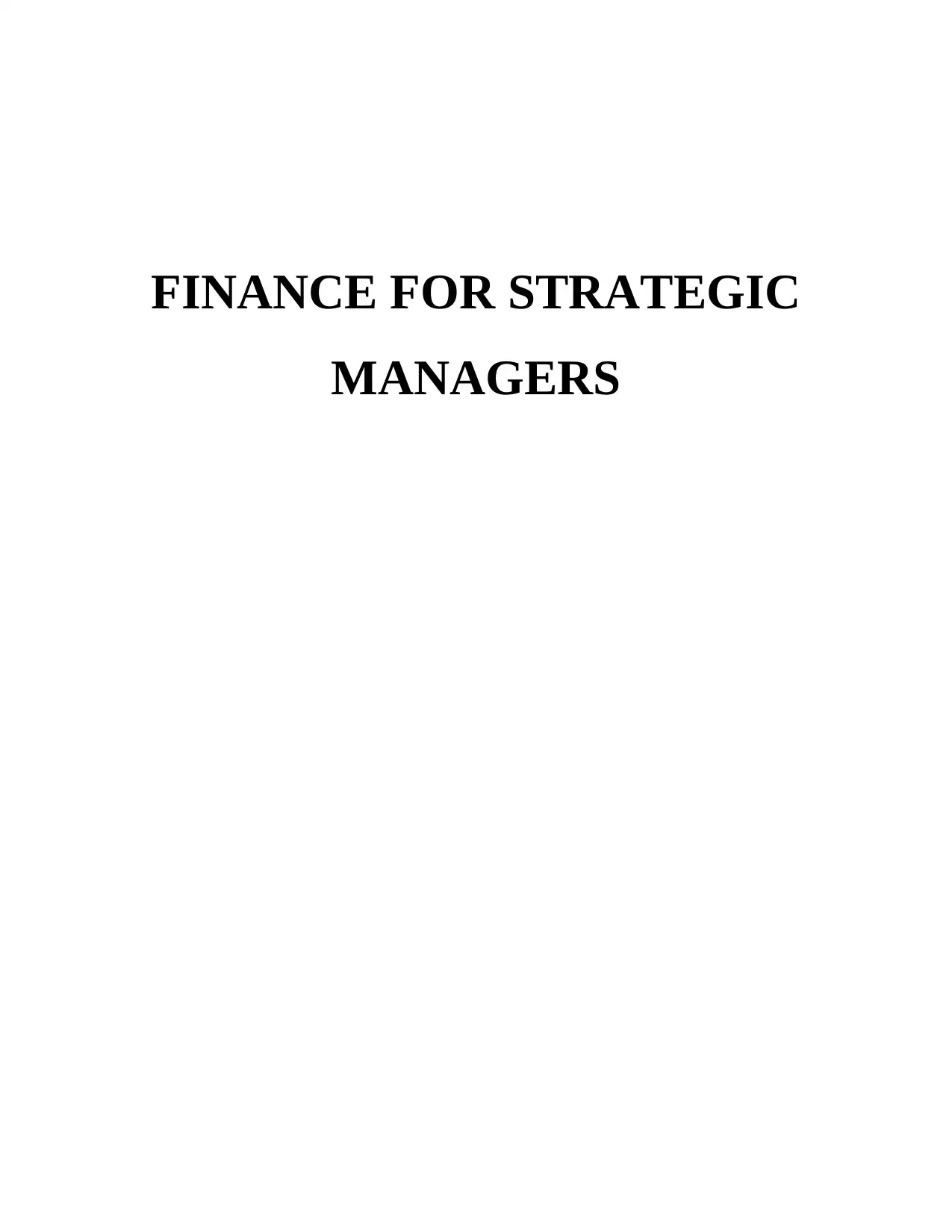
FINANCE FOR STRATEGIC
MANAGERS
MANAGERS
Paraphrase This Document
Need a fresh take? Get an instant paraphrase of this document with our AI Paraphraser

TABLE OF CONTENTS
INTRODUCTION...........................................................................................................................1
Activity 1.........................................................................................................................................1
1. Assessing why financial information is needed in business...................................................1
2. Identifying business risks related to financial decisions.........................................................2
3. Summary of financial information required to make strategic business decisions.................3
ACTIVITY 2....................................................................................................................................4
1.purpose, structure and content of published financial statement.............................................4
2. Interpretation of the financial statement ................................................................................8
3. Calculation of financial ratio from the statement ...................................................................9
Activity 3.......................................................................................................................................10
1. Difference between short and long financial requirements of business................................10
2. Long term and short term sources of finance .......................................................................12
3. Technique of cash flow management ..................................................................................13
ACTIVITY 4..................................................................................................................................15
1. Kind of ownership structure, their legal requirement and role of manager and owner in
these structure ...........................................................................................................................15
2. Methods of appraising strategic capital or investment project .............................................16
CONCLUSION..............................................................................................................................17
REFERENCES..............................................................................................................................18
INTRODUCTION...........................................................................................................................1
Activity 1.........................................................................................................................................1
1. Assessing why financial information is needed in business...................................................1
2. Identifying business risks related to financial decisions.........................................................2
3. Summary of financial information required to make strategic business decisions.................3
ACTIVITY 2....................................................................................................................................4
1.purpose, structure and content of published financial statement.............................................4
2. Interpretation of the financial statement ................................................................................8
3. Calculation of financial ratio from the statement ...................................................................9
Activity 3.......................................................................................................................................10
1. Difference between short and long financial requirements of business................................10
2. Long term and short term sources of finance .......................................................................12
3. Technique of cash flow management ..................................................................................13
ACTIVITY 4..................................................................................................................................15
1. Kind of ownership structure, their legal requirement and role of manager and owner in
these structure ...........................................................................................................................15
2. Methods of appraising strategic capital or investment project .............................................16
CONCLUSION..............................................................................................................................17
REFERENCES..............................................................................................................................18
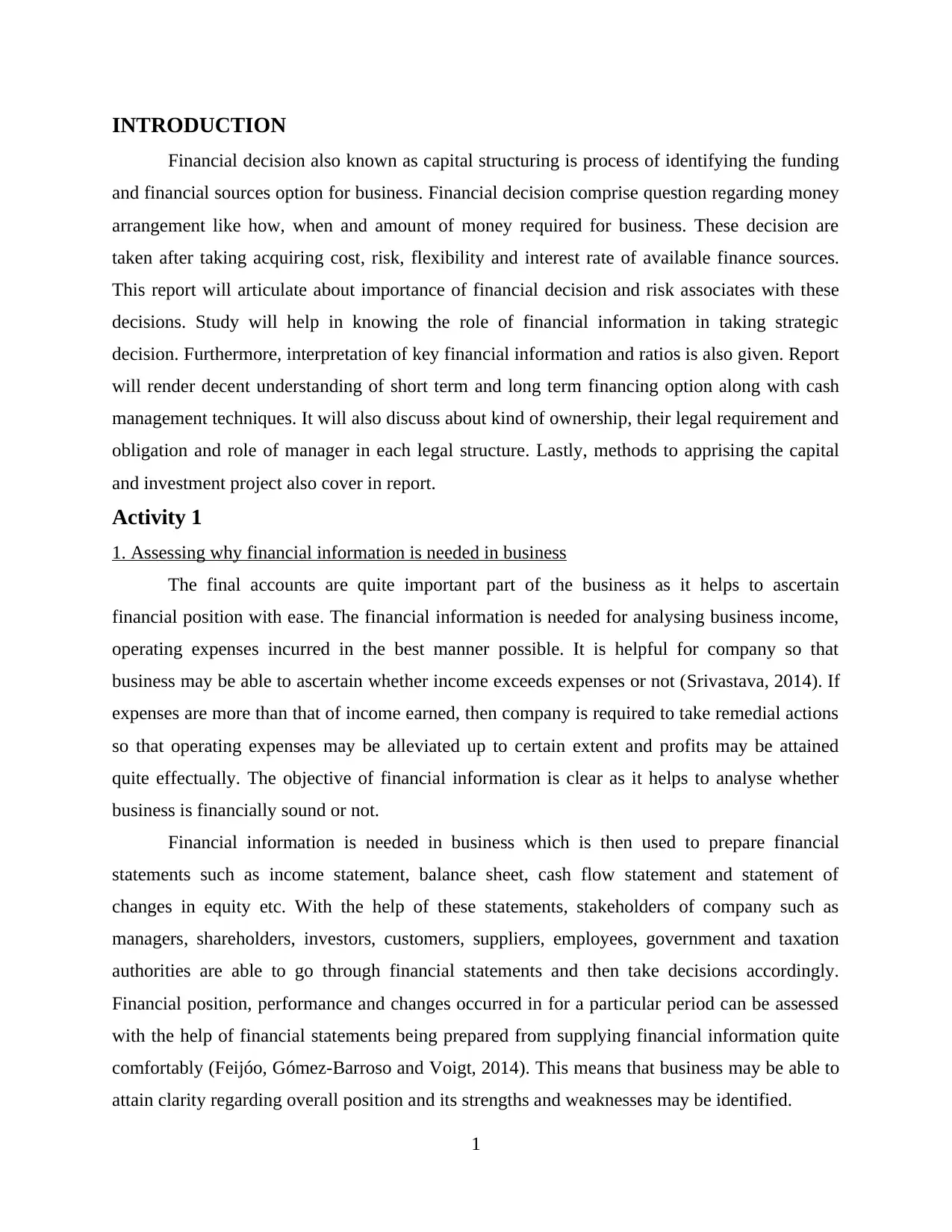
INTRODUCTION
Financial decision also known as capital structuring is process of identifying the funding
and financial sources option for business. Financial decision comprise question regarding money
arrangement like how, when and amount of money required for business. These decision are
taken after taking acquiring cost, risk, flexibility and interest rate of available finance sources.
This report will articulate about importance of financial decision and risk associates with these
decisions. Study will help in knowing the role of financial information in taking strategic
decision. Furthermore, interpretation of key financial information and ratios is also given. Report
will render decent understanding of short term and long term financing option along with cash
management techniques. It will also discuss about kind of ownership, their legal requirement and
obligation and role of manager in each legal structure. Lastly, methods to apprising the capital
and investment project also cover in report.
Activity 1
1. Assessing why financial information is needed in business
The final accounts are quite important part of the business as it helps to ascertain
financial position with ease. The financial information is needed for analysing business income,
operating expenses incurred in the best manner possible. It is helpful for company so that
business may be able to ascertain whether income exceeds expenses or not (Srivastava, 2014). If
expenses are more than that of income earned, then company is required to take remedial actions
so that operating expenses may be alleviated up to certain extent and profits may be attained
quite effectually. The objective of financial information is clear as it helps to analyse whether
business is financially sound or not.
Financial information is needed in business which is then used to prepare financial
statements such as income statement, balance sheet, cash flow statement and statement of
changes in equity etc. With the help of these statements, stakeholders of company such as
managers, shareholders, investors, customers, suppliers, employees, government and taxation
authorities are able to go through financial statements and then take decisions accordingly.
Financial position, performance and changes occurred in for a particular period can be assessed
with the help of financial statements being prepared from supplying financial information quite
comfortably (Feijóo, Gómez-Barroso and Voigt, 2014). This means that business may be able to
attain clarity regarding overall position and its strengths and weaknesses may be identified.
1
Financial decision also known as capital structuring is process of identifying the funding
and financial sources option for business. Financial decision comprise question regarding money
arrangement like how, when and amount of money required for business. These decision are
taken after taking acquiring cost, risk, flexibility and interest rate of available finance sources.
This report will articulate about importance of financial decision and risk associates with these
decisions. Study will help in knowing the role of financial information in taking strategic
decision. Furthermore, interpretation of key financial information and ratios is also given. Report
will render decent understanding of short term and long term financing option along with cash
management techniques. It will also discuss about kind of ownership, their legal requirement and
obligation and role of manager in each legal structure. Lastly, methods to apprising the capital
and investment project also cover in report.
Activity 1
1. Assessing why financial information is needed in business
The final accounts are quite important part of the business as it helps to ascertain
financial position with ease. The financial information is needed for analysing business income,
operating expenses incurred in the best manner possible. It is helpful for company so that
business may be able to ascertain whether income exceeds expenses or not (Srivastava, 2014). If
expenses are more than that of income earned, then company is required to take remedial actions
so that operating expenses may be alleviated up to certain extent and profits may be attained
quite effectually. The objective of financial information is clear as it helps to analyse whether
business is financially sound or not.
Financial information is needed in business which is then used to prepare financial
statements such as income statement, balance sheet, cash flow statement and statement of
changes in equity etc. With the help of these statements, stakeholders of company such as
managers, shareholders, investors, customers, suppliers, employees, government and taxation
authorities are able to go through financial statements and then take decisions accordingly.
Financial position, performance and changes occurred in for a particular period can be assessed
with the help of financial statements being prepared from supplying financial information quite
comfortably (Feijóo, Gómez-Barroso and Voigt, 2014). This means that business may be able to
attain clarity regarding overall position and its strengths and weaknesses may be identified.
1
⊘ This is a preview!⊘
Do you want full access?
Subscribe today to unlock all pages.

Trusted by 1+ million students worldwide

In accordance to financial position, company may be able to take decisions which will
enhance its position in the future. This will help to make well-structured decisions and as a
result, it may be able to accomplish desired profits by initiating healthy strategies. Thus, it can be
said that financial information is quite useful for business in analysing information in the best
way possible and take righteous decisions by incorporating strategies and achieve goals with
ease. Moreover, control may be initiated on expenses so as to reduce the same which obstacles in
garnering profits and thus, business would be able to attain stated goals by having transparent
financial information through financial statements.
2. Identifying business risks related to financial decisions
The business risks is termed as potential for organisation's actual returns varying from
expected returns. The type of business risks depends upon the operational activities being
conducted by company. Moreover, business risks which relates to financial decisions are listed
below-
Financial Risks
The financial risk arises due to events that weaken earnings of organisation and as a
result, affect shareholder's wealth up to a major extent. Shareholder's wealth will be diluted
because they may value organisation by discounting firm's projected cash flows. These types of
risks including changes in equity prices, credit spreads, interest rates, commodity and credit
which are risks to capital of company as it becomes unable to meet its present financial
obligations and not incurring significant losses (Macedo, Pinho and Silva, 2016). Thus, it is
required to ascertain risks in order to ascertain inaccuracy and make timely remedial actions.
Operational Risks
It is another risks which arises due to making financial decisions. The operational risk is
particularly related to organisation's internal activities and includes process risk. It pertains to
lack of desired resources which are essential for making up operational tasks in the best manner
possible. It includes employees, processes, materials and necessary equipments and machineries
(Nordmeyer. 2018). These are the inputs which are used for producing outputs in effective
manner. It can be said that business requires these inputs and in the absence of any of these
resources, outputs cannot be produced and thus, risk arises.
2
enhance its position in the future. This will help to make well-structured decisions and as a
result, it may be able to accomplish desired profits by initiating healthy strategies. Thus, it can be
said that financial information is quite useful for business in analysing information in the best
way possible and take righteous decisions by incorporating strategies and achieve goals with
ease. Moreover, control may be initiated on expenses so as to reduce the same which obstacles in
garnering profits and thus, business would be able to attain stated goals by having transparent
financial information through financial statements.
2. Identifying business risks related to financial decisions
The business risks is termed as potential for organisation's actual returns varying from
expected returns. The type of business risks depends upon the operational activities being
conducted by company. Moreover, business risks which relates to financial decisions are listed
below-
Financial Risks
The financial risk arises due to events that weaken earnings of organisation and as a
result, affect shareholder's wealth up to a major extent. Shareholder's wealth will be diluted
because they may value organisation by discounting firm's projected cash flows. These types of
risks including changes in equity prices, credit spreads, interest rates, commodity and credit
which are risks to capital of company as it becomes unable to meet its present financial
obligations and not incurring significant losses (Macedo, Pinho and Silva, 2016). Thus, it is
required to ascertain risks in order to ascertain inaccuracy and make timely remedial actions.
Operational Risks
It is another risks which arises due to making financial decisions. The operational risk is
particularly related to organisation's internal activities and includes process risk. It pertains to
lack of desired resources which are essential for making up operational tasks in the best manner
possible. It includes employees, processes, materials and necessary equipments and machineries
(Nordmeyer. 2018). These are the inputs which are used for producing outputs in effective
manner. It can be said that business requires these inputs and in the absence of any of these
resources, outputs cannot be produced and thus, risk arises.
2
Paraphrase This Document
Need a fresh take? Get an instant paraphrase of this document with our AI Paraphraser

Strategic Risks
The strategic risk is related to business environment where organization operates. The
business activities and company's communication with investors. On the other hand, business
environmental risk means to issue with the markets in which company buys and sells goods and
services and government regulations and relate compliance issues. This means that business
needs to make well-structured strategies and as a result, strategic risk can be minimized. It also
includes unfavorable downturn in supply or demand for organization's commodities and rivals
with whom business competes for revenue and supplies up to a maximum possible extent.
3. Summary of financial information required to make strategic business decisions
The financial information is required and it can be ascertained by preparing three basic
financial reports such as balance sheet, income statement and cash flow statement which should
be in accordance to the guidelines being issued by GAAP (Generally Accepted Accounting
Principles). This is because it will be difficult for making strategic decisions on the basis of
inaccurate financial information. These are listed below-
Balance sheet
It is summary of business position at a certain point of time highlighting assets, liabiities
and shareholder's equity. It provides picture of strength of business and days of working capital
implying how effectively company could handle changes in sales. Balance sheet is also helpful
in identifying such as debtors cycle works and how net profits are being utilised and how often
machinery is replaced (Evans, Hodder and Hopkins, 2014). Thus, financial position helps to take
strategic decisions.
Income statement
It is another useful statement which helps to ascertain revenue and expenses during the
particular point of time, usually it is prepared at the end of financial year. The major purpose of
preparation of income statement is to show how firm has performed over the past year which
lists down sales and expenditures and profit or loss accomplished serving need for strategic
decision-making in the best manner possible.
Cash flow statement
The cash flow statement outlines inflows and outflows of cash for the particular period.
The cash movements are outlined for time and also it highlights various activities in which cash
inflows and outflows are arrived. The cash flow statement has three activities such as operating
3
The strategic risk is related to business environment where organization operates. The
business activities and company's communication with investors. On the other hand, business
environmental risk means to issue with the markets in which company buys and sells goods and
services and government regulations and relate compliance issues. This means that business
needs to make well-structured strategies and as a result, strategic risk can be minimized. It also
includes unfavorable downturn in supply or demand for organization's commodities and rivals
with whom business competes for revenue and supplies up to a maximum possible extent.
3. Summary of financial information required to make strategic business decisions
The financial information is required and it can be ascertained by preparing three basic
financial reports such as balance sheet, income statement and cash flow statement which should
be in accordance to the guidelines being issued by GAAP (Generally Accepted Accounting
Principles). This is because it will be difficult for making strategic decisions on the basis of
inaccurate financial information. These are listed below-
Balance sheet
It is summary of business position at a certain point of time highlighting assets, liabiities
and shareholder's equity. It provides picture of strength of business and days of working capital
implying how effectively company could handle changes in sales. Balance sheet is also helpful
in identifying such as debtors cycle works and how net profits are being utilised and how often
machinery is replaced (Evans, Hodder and Hopkins, 2014). Thus, financial position helps to take
strategic decisions.
Income statement
It is another useful statement which helps to ascertain revenue and expenses during the
particular point of time, usually it is prepared at the end of financial year. The major purpose of
preparation of income statement is to show how firm has performed over the past year which
lists down sales and expenditures and profit or loss accomplished serving need for strategic
decision-making in the best manner possible.
Cash flow statement
The cash flow statement outlines inflows and outflows of cash for the particular period.
The cash movements are outlined for time and also it highlights various activities in which cash
inflows and outflows are arrived. The cash flow statement has three activities such as operating
3
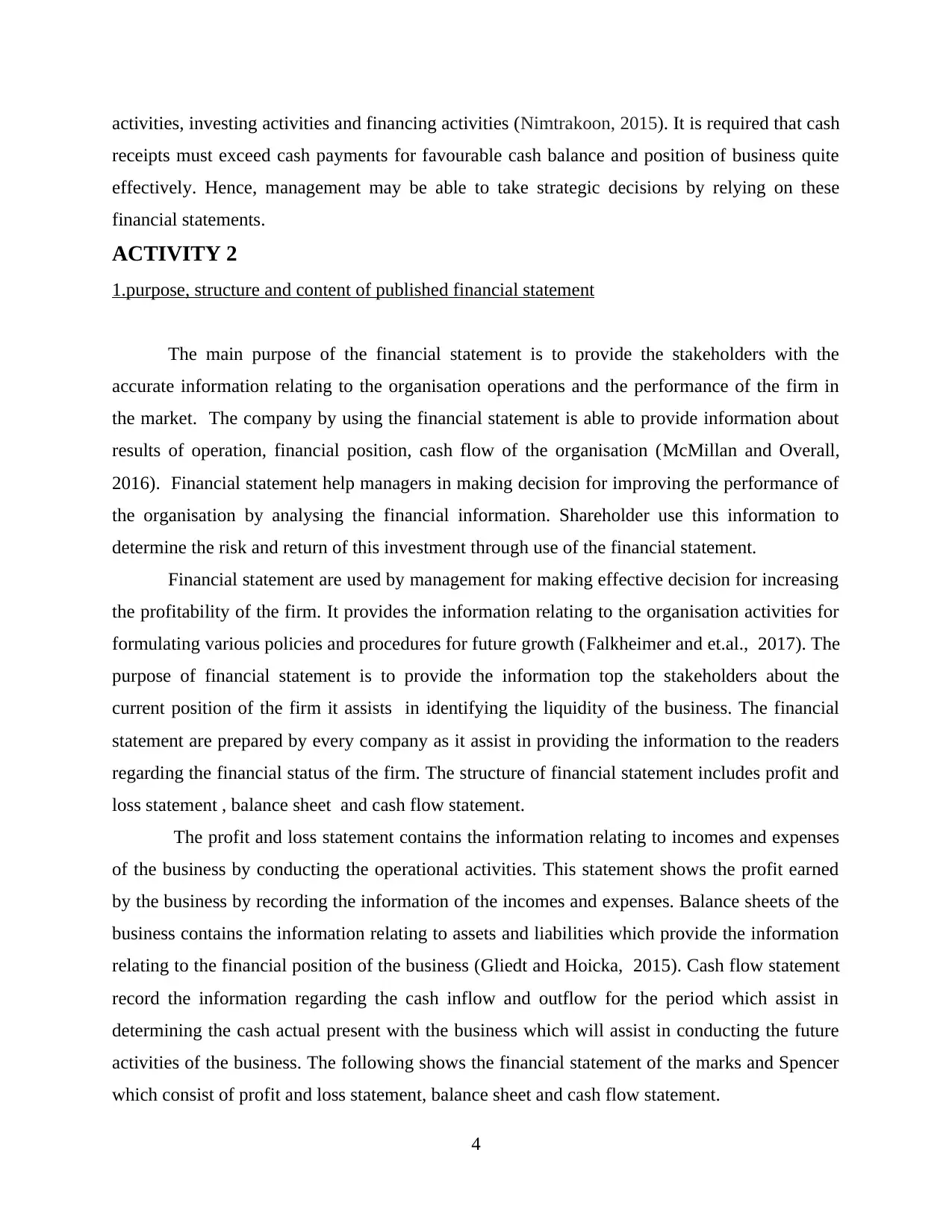
activities, investing activities and financing activities (Nimtrakoon, 2015). It is required that cash
receipts must exceed cash payments for favourable cash balance and position of business quite
effectively. Hence, management may be able to take strategic decisions by relying on these
financial statements.
ACTIVITY 2
1.purpose, structure and content of published financial statement
The main purpose of the financial statement is to provide the stakeholders with the
accurate information relating to the organisation operations and the performance of the firm in
the market. The company by using the financial statement is able to provide information about
results of operation, financial position, cash flow of the organisation (McMillan and Overall,
2016). Financial statement help managers in making decision for improving the performance of
the organisation by analysing the financial information. Shareholder use this information to
determine the risk and return of this investment through use of the financial statement.
Financial statement are used by management for making effective decision for increasing
the profitability of the firm. It provides the information relating to the organisation activities for
formulating various policies and procedures for future growth (Falkheimer and et.al., 2017). The
purpose of financial statement is to provide the information top the stakeholders about the
current position of the firm it assists in identifying the liquidity of the business. The financial
statement are prepared by every company as it assist in providing the information to the readers
regarding the financial status of the firm. The structure of financial statement includes profit and
loss statement , balance sheet and cash flow statement.
The profit and loss statement contains the information relating to incomes and expenses
of the business by conducting the operational activities. This statement shows the profit earned
by the business by recording the information of the incomes and expenses. Balance sheets of the
business contains the information relating to assets and liabilities which provide the information
relating to the financial position of the business (Gliedt and Hoicka, 2015). Cash flow statement
record the information regarding the cash inflow and outflow for the period which assist in
determining the cash actual present with the business which will assist in conducting the future
activities of the business. The following shows the financial statement of the marks and Spencer
which consist of profit and loss statement, balance sheet and cash flow statement.
4
receipts must exceed cash payments for favourable cash balance and position of business quite
effectively. Hence, management may be able to take strategic decisions by relying on these
financial statements.
ACTIVITY 2
1.purpose, structure and content of published financial statement
The main purpose of the financial statement is to provide the stakeholders with the
accurate information relating to the organisation operations and the performance of the firm in
the market. The company by using the financial statement is able to provide information about
results of operation, financial position, cash flow of the organisation (McMillan and Overall,
2016). Financial statement help managers in making decision for improving the performance of
the organisation by analysing the financial information. Shareholder use this information to
determine the risk and return of this investment through use of the financial statement.
Financial statement are used by management for making effective decision for increasing
the profitability of the firm. It provides the information relating to the organisation activities for
formulating various policies and procedures for future growth (Falkheimer and et.al., 2017). The
purpose of financial statement is to provide the information top the stakeholders about the
current position of the firm it assists in identifying the liquidity of the business. The financial
statement are prepared by every company as it assist in providing the information to the readers
regarding the financial status of the firm. The structure of financial statement includes profit and
loss statement , balance sheet and cash flow statement.
The profit and loss statement contains the information relating to incomes and expenses
of the business by conducting the operational activities. This statement shows the profit earned
by the business by recording the information of the incomes and expenses. Balance sheets of the
business contains the information relating to assets and liabilities which provide the information
relating to the financial position of the business (Gliedt and Hoicka, 2015). Cash flow statement
record the information regarding the cash inflow and outflow for the period which assist in
determining the cash actual present with the business which will assist in conducting the future
activities of the business. The following shows the financial statement of the marks and Spencer
which consist of profit and loss statement, balance sheet and cash flow statement.
4
⊘ This is a preview!⊘
Do you want full access?
Subscribe today to unlock all pages.

Trusted by 1+ million students worldwide
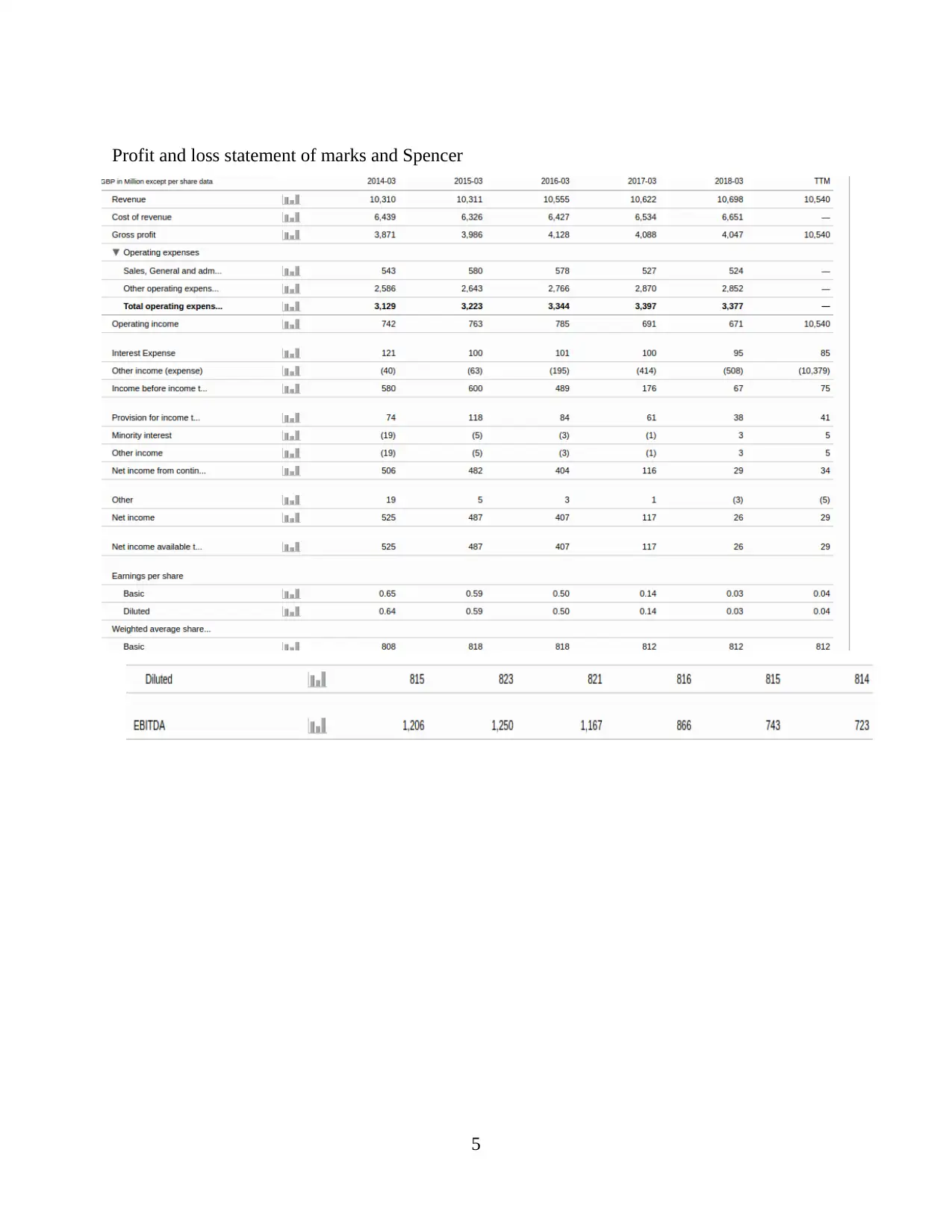
Profit and loss statement of marks and Spencer
5
5
Paraphrase This Document
Need a fresh take? Get an instant paraphrase of this document with our AI Paraphraser
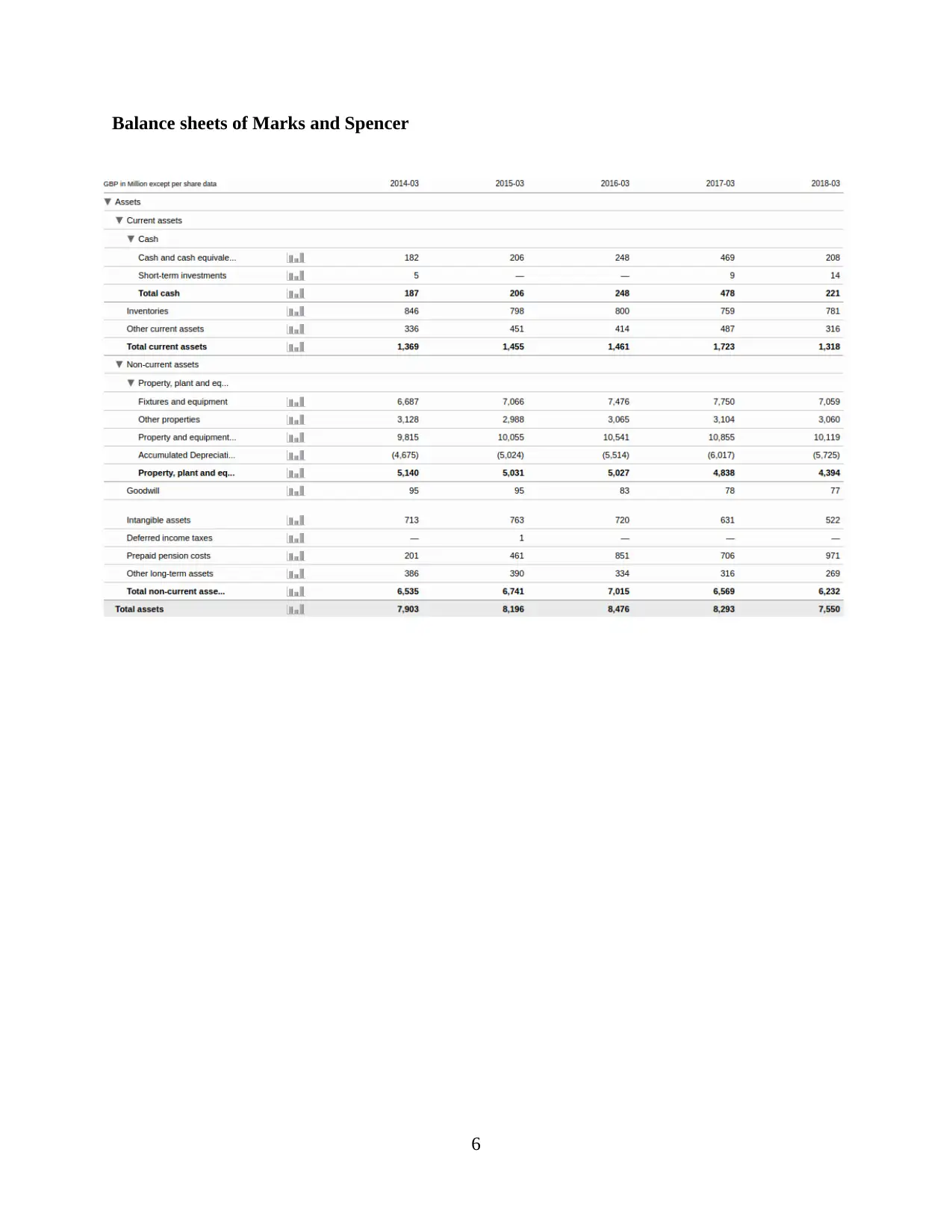
Balance sheets of Marks and Spencer
6
6
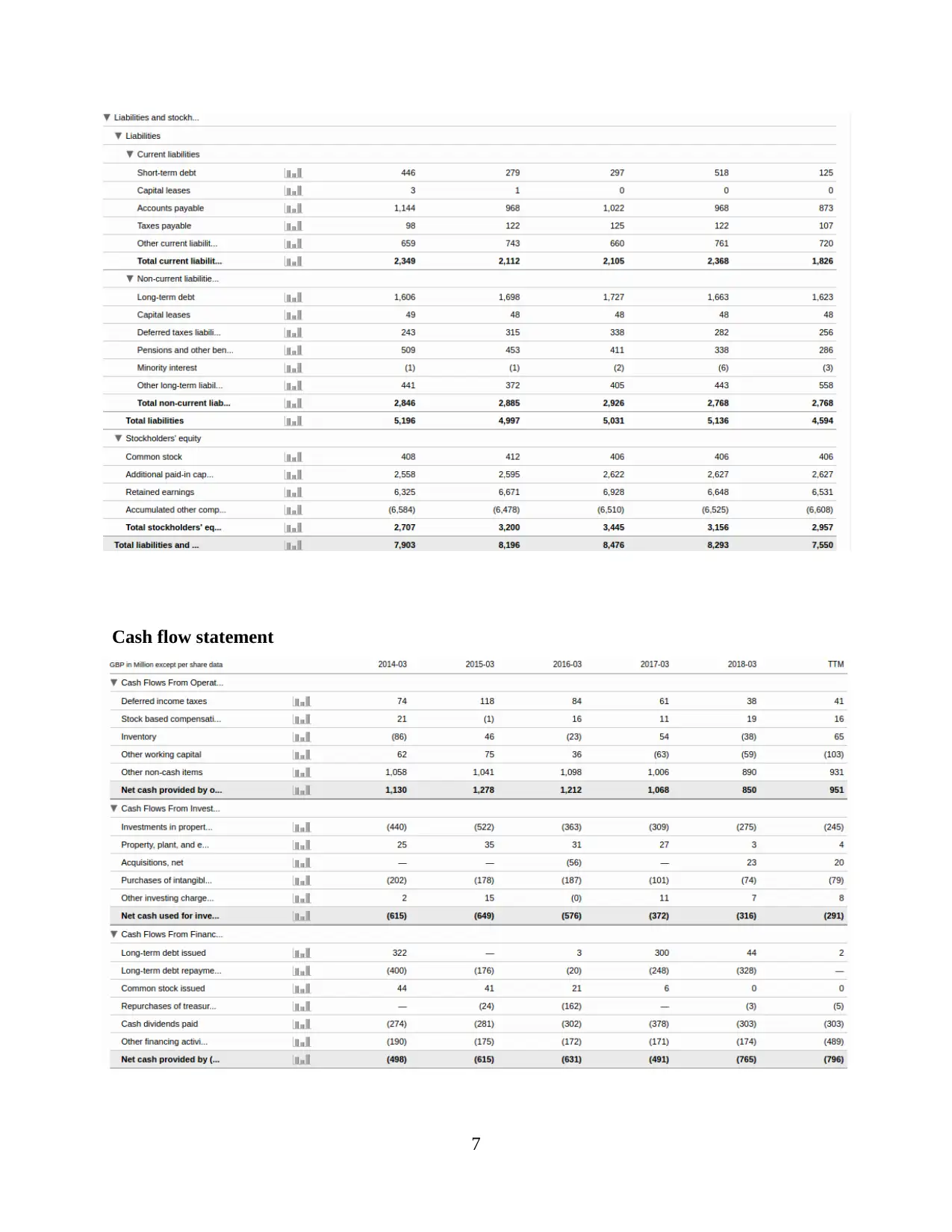
Cash flow statement
7
7
⊘ This is a preview!⊘
Do you want full access?
Subscribe today to unlock all pages.

Trusted by 1+ million students worldwide

2. Interpretation of the financial statement
The financial statement shown in the above question includes the profit and loss
statement balance sheet and cash flow statement of marks and Spencer.
Interpretation of profit and loss statement : The profit and loss statement is prepared
in order to determine the profits earned by the business. This statement assist in improving the
future performance and profitability by making affective strategies for increasing the profitability
by improving the area which increased the expenses. From the income statement it can be
interpreted that Gross profit of marks and Spencer in year 2018 is $4,047 and its total operating
expenses in the same year were $3377 and its operating income is $671 and its net profit for the
period is $26.It provides that Marks and Spencer earned the profit of $26 in the year 2018.
Interpretation of Balance sheet : The balance sheet contains the information relating to
assets and liabilities of Marks and Spencer. It assists in identifying the financial position of the
business on a particular date. From the above balance sheet of Marks and Spencer it can be
interpreted that it have total cash equals to 221. Its total current assets are 1318 and total non –
current equals to 6232. Marks and Spencer have total current liabilities equal to 1826 in the year
2018.moreover, It has non current liabilities which is equal to 2768 in 2018. Furthermore, the
total shareholder equity of Marks and Spencer is 2957. It shows that the organisation financial
position on a specific date.
Interpretation of cash flow statement : Cash flow statement consist of three activities
which includes operating activity, investing activity and financing activity. From the cash flow
statement of Marks and Spencer it can be interpreted that net cash as per the operating activity is
determined as $850 in the year 2018. Moreover, The Net cash used for investing activity is equal
8
The financial statement shown in the above question includes the profit and loss
statement balance sheet and cash flow statement of marks and Spencer.
Interpretation of profit and loss statement : The profit and loss statement is prepared
in order to determine the profits earned by the business. This statement assist in improving the
future performance and profitability by making affective strategies for increasing the profitability
by improving the area which increased the expenses. From the income statement it can be
interpreted that Gross profit of marks and Spencer in year 2018 is $4,047 and its total operating
expenses in the same year were $3377 and its operating income is $671 and its net profit for the
period is $26.It provides that Marks and Spencer earned the profit of $26 in the year 2018.
Interpretation of Balance sheet : The balance sheet contains the information relating to
assets and liabilities of Marks and Spencer. It assists in identifying the financial position of the
business on a particular date. From the above balance sheet of Marks and Spencer it can be
interpreted that it have total cash equals to 221. Its total current assets are 1318 and total non –
current equals to 6232. Marks and Spencer have total current liabilities equal to 1826 in the year
2018.moreover, It has non current liabilities which is equal to 2768 in 2018. Furthermore, the
total shareholder equity of Marks and Spencer is 2957. It shows that the organisation financial
position on a specific date.
Interpretation of cash flow statement : Cash flow statement consist of three activities
which includes operating activity, investing activity and financing activity. From the cash flow
statement of Marks and Spencer it can be interpreted that net cash as per the operating activity is
determined as $850 in the year 2018. Moreover, The Net cash used for investing activity is equal
8
Paraphrase This Document
Need a fresh take? Get an instant paraphrase of this document with our AI Paraphraser
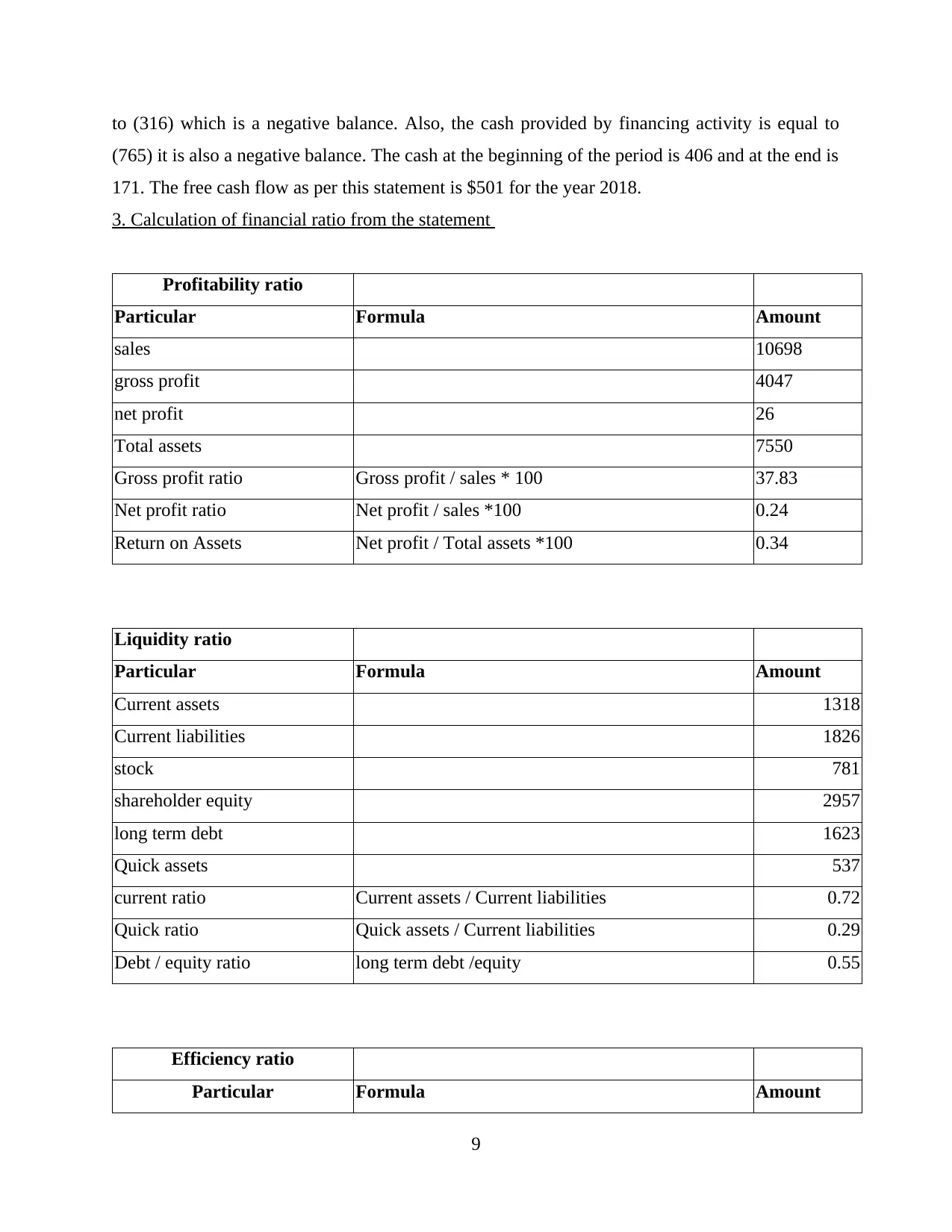
to (316) which is a negative balance. Also, the cash provided by financing activity is equal to
(765) it is also a negative balance. The cash at the beginning of the period is 406 and at the end is
171. The free cash flow as per this statement is $501 for the year 2018.
3. Calculation of financial ratio from the statement
Profitability ratio
Particular Formula Amount
sales 10698
gross profit 4047
net profit 26
Total assets 7550
Gross profit ratio Gross profit / sales * 100 37.83
Net profit ratio Net profit / sales *100 0.24
Return on Assets Net profit / Total assets *100 0.34
Liquidity ratio
Particular Formula Amount
Current assets 1318
Current liabilities 1826
stock 781
shareholder equity 2957
long term debt 1623
Quick assets 537
current ratio Current assets / Current liabilities 0.72
Quick ratio Quick assets / Current liabilities 0.29
Debt / equity ratio long term debt /equity 0.55
Efficiency ratio
Particular Formula Amount
9
(765) it is also a negative balance. The cash at the beginning of the period is 406 and at the end is
171. The free cash flow as per this statement is $501 for the year 2018.
3. Calculation of financial ratio from the statement
Profitability ratio
Particular Formula Amount
sales 10698
gross profit 4047
net profit 26
Total assets 7550
Gross profit ratio Gross profit / sales * 100 37.83
Net profit ratio Net profit / sales *100 0.24
Return on Assets Net profit / Total assets *100 0.34
Liquidity ratio
Particular Formula Amount
Current assets 1318
Current liabilities 1826
stock 781
shareholder equity 2957
long term debt 1623
Quick assets 537
current ratio Current assets / Current liabilities 0.72
Quick ratio Quick assets / Current liabilities 0.29
Debt / equity ratio long term debt /equity 0.55
Efficiency ratio
Particular Formula Amount
9

COGS Sales – Gross profit 6651
Opening stock 759
closing stock 781
Average stock Opening inventory + closing inventory/2 770
opening fixed assets 6569
closing fixed assets 6232
Total fixed assets 4394
Sales revenue 10698
Opening total assets 8293
Closing Total assets 7550
Average fixed assets Opening fixed assets + closing fixed assets /2 6401
Average total assets Opening + closing /2 7922
Stock turnover ratio COGS / Average inventory 8.64
Fixed assets turnover ratio Sales / Total fixed assets 1.67
Total assets turnover ratio Sales / Total assets 1.35
Investment ratio
Particular Amount
EPS 0.03
DPS 0.38
Marks and Spencer by suing this ratio is able to make effective decision for the future by
using the ratio such as profitability ratio the organisations able to identify the profitability by
using the net profit ratio, gross profit ratio and return on assets. Moreover, The organisation by
using this ratio can improve its performance by implementing various strategies for increasing
the revenue. Moreover, the Firm By using the liquidity ratios is able to identify its liquidity
position by identifying the current assets and liabilities (Hirshleifer, 2015). It provides
information to the company that it is having current assets for meeting its current obligations.
Efficiency ratio support the firm in identifying the information that the assets are used properly
for increasing the sales revenue. The investing ratio assist in providing information about the
10
Opening stock 759
closing stock 781
Average stock Opening inventory + closing inventory/2 770
opening fixed assets 6569
closing fixed assets 6232
Total fixed assets 4394
Sales revenue 10698
Opening total assets 8293
Closing Total assets 7550
Average fixed assets Opening fixed assets + closing fixed assets /2 6401
Average total assets Opening + closing /2 7922
Stock turnover ratio COGS / Average inventory 8.64
Fixed assets turnover ratio Sales / Total fixed assets 1.67
Total assets turnover ratio Sales / Total assets 1.35
Investment ratio
Particular Amount
EPS 0.03
DPS 0.38
Marks and Spencer by suing this ratio is able to make effective decision for the future by
using the ratio such as profitability ratio the organisations able to identify the profitability by
using the net profit ratio, gross profit ratio and return on assets. Moreover, The organisation by
using this ratio can improve its performance by implementing various strategies for increasing
the revenue. Moreover, the Firm By using the liquidity ratios is able to identify its liquidity
position by identifying the current assets and liabilities (Hirshleifer, 2015). It provides
information to the company that it is having current assets for meeting its current obligations.
Efficiency ratio support the firm in identifying the information that the assets are used properly
for increasing the sales revenue. The investing ratio assist in providing information about the
10
⊘ This is a preview!⊘
Do you want full access?
Subscribe today to unlock all pages.

Trusted by 1+ million students worldwide
1 out of 22
Related Documents
Your All-in-One AI-Powered Toolkit for Academic Success.
+13062052269
info@desklib.com
Available 24*7 on WhatsApp / Email
![[object Object]](/_next/static/media/star-bottom.7253800d.svg)
Unlock your academic potential
Copyright © 2020–2025 A2Z Services. All Rights Reserved. Developed and managed by ZUCOL.





